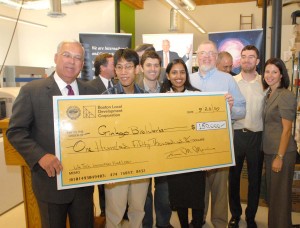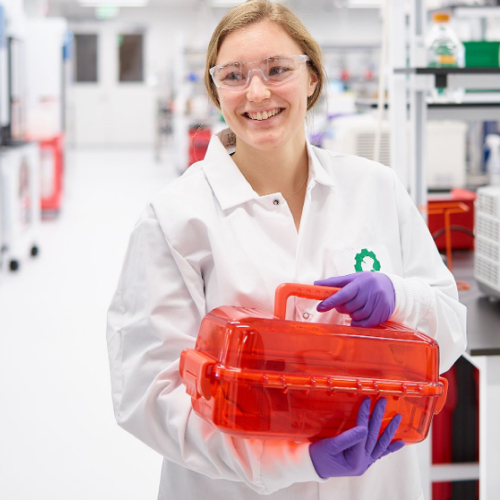It’s been a big week here at Ginkgo and for the future of the bioeconomy!
The White House issued an executive order to launch a national biotechnology and biomanufacturing initiative & tapped Ginkgo’s Renee Wegrzyn to lead the Advanced Research Projects Agency for Health.
The White House has made it clear: the future lies in biotechnology. On Monday, Sept. 12, President Biden signed an executive order – Advancing Biotechnology and Biomanufacturing Innovation for a Sustainable, Safe, and Secure American Bioeconomy – that launched a national biotechnology and biomanufacturing initiative. The executive order will accelerate the use of biotech in industries such as agriculture, medicine, and energy as an alternative to fossil fuel-based products.
Also on Monday: Dr. Renee Wegrzyn — Ginkgo’s very own Vice President of Business Development — was tapped by President Joe Biden to lead the Advanced Research Projects Agency for Health (ARPA-H) as its first director. ARPA-H is a new government agency, formed in March 2022, that will drive biomedical innovation to support the health of all Americans.
Then, on Wednesday, Sept. 14, Ginkgo’s CEO Jason Kelly joined a Summit on Biotechnology and Biomanufacturing, hosted at the White House. Government and industry leaders discussed how to grow the bioeconomy and better leverage it against our most pressing economic, ecological, and societal challenges like climate change and supply chain insecurity. Jason spoke about being at the forefront of “the DNA Age” and noted the importance that this industry be built with care and U.S. values. Read Jason’s full remarks below.
The new Executive Order on Biotechnology and Biomanufacturing stands to have a momentous impact on the industry.
The executive order contains a wide array of new efforts by the U.S. government to support the wider synthetic biology and biotechnology sector. Read the full White House fact sheet here for a quick overview. Here’s a snapshot of the initiative objectives:
- Grow domestic biomanufacturing capacity
- Expand market opportunities for bio-based products
- Drive research and development to solve our greatest challenges
- Improve access to quality federal data
- Train a diverse skilled workforce
- Streamline regulations for products of biotechnology
- Advance biosafety and biosecurity to reduce risk
- Protect the U.S. biotechnology ecosystem
- Build a thriving, secure global bioeconomy with partners and allies
Ginkgo’s Renee Wegrzyn asked to lead ARPA-H
Ginkgo is feeling OVER THE MOON that Dr. Renee Wegrzyn, our current Vice President of Business Development, has been asked to be the inaugural Director of ARPA-H. Renee will be charged with shaping the agency’s vision and approach from the ground up. We at Ginkgo know that Renee is the perfect person to meet this moment. Before Ginkgo, Renee accrued a diverse set of experiences leading R&D teams in industry and serving as a Program Manager at DARPA. She’s spent the past two years developing Ginkgo’s biosecurity innovation pipeline, implementing new tools to combat infectious disease, and shaping our emergency COVID-19 response.
We will miss Renee dearly, but view her upcoming appointment as a huge signal of progress for the future of biotech, pharmaceuticals, and medical innovation. We feel this is a major leap forward in creating an equitable, resilient, and innovative health system. Read the full White House announcement about Renee here.
Read through our CEO Jason Kelly’s full remarks from the White House Summit on Biotechnology and Biomanufacturing.
Jason visited the White House on Wednesday to discuss the future of biotechnology with government officials and industry leaders. Many topics were explored, like bringing bio-products to market, expanding domestic biomanufacturing, and using biotech to strengthen supply chains as well as fostering a diverse, skilled workforce and next generation of leaders.
Watch the recording of the full Summit or read a transcript of Jason’s live remarks below.
“Today, Ginkgo is the largest designer of synthetic DNA in the world. What does that mean? It means you go on a computer, you type ‘ATCGGG,’ you hit print, and a piece of DNA gets printed out of our labs in Boston or partner companies like Twist in California. We then take that DNA, and we put it into the genome of a cell – like installing an app on your phone. And it makes the cell do something new! That’s our business. We do that as a service for customers.
So what types of applications are we seeing our customers ask for? Well, we work with Bayer Crop Science on a project – a $100 million project – to engineer microbes to produce fertilizer for crops. We’re helping them develop microbes that take nitrogen right out of the air and feed it to the crop. If you are successful at this, that’s 1 to 2% of global greenhouse gas, and it’s a big supply chain problem as we know today – that’s just one project.
We have a project with a company called Allonnia that’s asked us to engineer microbes to break down PFAS. This is something where the administration’s really led, thanks to the EPA, to get this chemical out of our water sources.
We’ve worked with companies that want rare disease treatments to ones that focus on rare earth element recovery.
The range on bioengineering is unbelievable. To me, this means that the DNA Age that’s coming is going to be more important than the Electronics Age that we saw over the last 75 years.
While biology is programmable like electronics and computers, it’s important to note that it’s not predictable like computers. We saw this with COVID-19 – biology can get out of control. And so it was great to hear the comments [earlier during this summit] about biosecurity and biosafety. I think this is going to be absolutely critical as we do that. So we’ve been lucky to work with the CDC — with their airports program — that caught the first cases of the BA.2 and BA.3 variants entering the US with our surveillance sequencing program. This is the beginning of a ‘hurricane warning system’ for infectious disease. We have to have this stuff as we enter the age of programmed biology.
We work with the US Department of Health and Human Services(HHS) through Operation Expanded Testing. This is in my opinion one of the most important biosecurity programs in the country: it kept schools open through the Omicron wave and it’s rolled out nationwide testing available for free in schools. Enormously important.
The last thing I want to say is as we’re building this technology, it’s extremely important that we do it with care. It was excellent to hear the comments about wanting to share the benefits of this technology with the wider public. I think it’s also important to note, we want the wider public to participate in this technology. We spend a lot of time on literacy. We teach people to read and write. We need bio literacy. We need to teach people to read and write DNA so that they’re not just receiving the benefits of this, they’re the actual creators of this in the future. I want to say the DNA Age is coming, and I want to thank you all for your leadership in making sure that it’s built on US values.” — Jason Kelly, CEO of Ginkgo Bioworks
Find the full press release detailing the ARPA-H announcement here along with all of the latest news from the Ginkgo team.
Exciting times ahead! What will you grow with Ginkgo?

